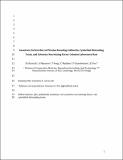Genotoxic Escherichia coli Strains Encoding Colibactin, Cytolethal Distending Toxin, and Cytotoxic Necrotizing Factor in Laboratory Rats
Author(s)
Kurnick, Susanna A; Mannion, Anthony; Feng, Yan; Madden, Carolyn; Chamberlain Jr, Paul; Fox, James G; ... Show more Show less
DownloadAccepted version (498.4Kb)
Open Access Policy
Open Access Policy
Creative Commons Attribution-Noncommercial-Share Alike
Additional downloads
Open Access Policy
Open Access Policy
Creative Commons Attribution-Noncommercial-Share Alike
Terms of use
Metadata
Show full item recordAbstract
Although many Escherichia coli strains are considered commensals in mammals, strains encoding the cyclomodulin genotoxins are associated with clinical and subclinical disease in the urogenital and gastrointestinal tracts, meningitis, and inflammatory disorders. These genotoxins include the polyketide synthase (pks) pathogenicity island, cytolethal distending toxin (cdt), and hemolysin-associated cytotoxic necrotizing factor (cnf). E. coli strains are not excluded from rodents housed under SPF conditions in academic or vendor facilities. This study isolated and characterized genotoxin-encoding E. coli from laboratory rats obtained from 4 academic institutions and 3 vendors. A total of 69 distinct E. coli isolates were cultured from feces, rectal swab, nares, or vaginal swab of 52 rats and characterized biochemically. PCR analysis for cyclomodulin genes and phylogroup was performed on all 69 isolates. Of the 69 isolates, 45 (65%) were positive for pks, 20/69 (29%) were positive for cdt, and 4 (6%) were positive for cnf. Colibactin was the sole genotoxin identified in 21 of 45 pks+ isolates (47%), whereas cdt or cnf was also present in the remaining 24 isolates (53%); cdt and cnf were never present together or without pks. All genotoxin-associated strains were members of pathogen-associated phylogroup B2. Fisher exact and χ² tests demonstrated significant differences in genotoxin prevalence and API code distribution with regard to vendor. Select E. coli isolates were characterized by HeLa cell in vitro cytotoxicity assays, serotyped, and whole-genome sequenced. All isolates encoding cyclomodulins induced megalocytosis. Serotypes corresponded with vendor origin and cyclomodulin composition, with the cnf+ serotype representing a known human uropathogen. Whole-genome sequencing confirmed the presence of complete pks, cdt, and hemolysin-cnf pathogenicity islands. These findings indicate that genotoxin-encoding E. coli colonize laboratory rats from multiple commercial vendors and academic institutions and suggest the potential to contribute to clinical disease and introduce confounding variables into experimental rat models.
Date issued
2019-04Department
Massachusetts Institute of Technology. Division of Comparative MedicineJournal
Comparative Medicine
Publisher
American Association for Laboratory Animal Science
Citation
Kurnick, Susanna A. et al. "Genotoxic Escherichia coli Strains Encoding Colibactin, Cytolethal Distending Toxin, and Cytotoxic Necrotizing Factor in Laboratory Rats." Comparative Medicine 69, 2 (April 2019): 103-113 © 2019 American Association for Laboratory Animal Science
Version: Author's final manuscript
ISSN
1532-0820